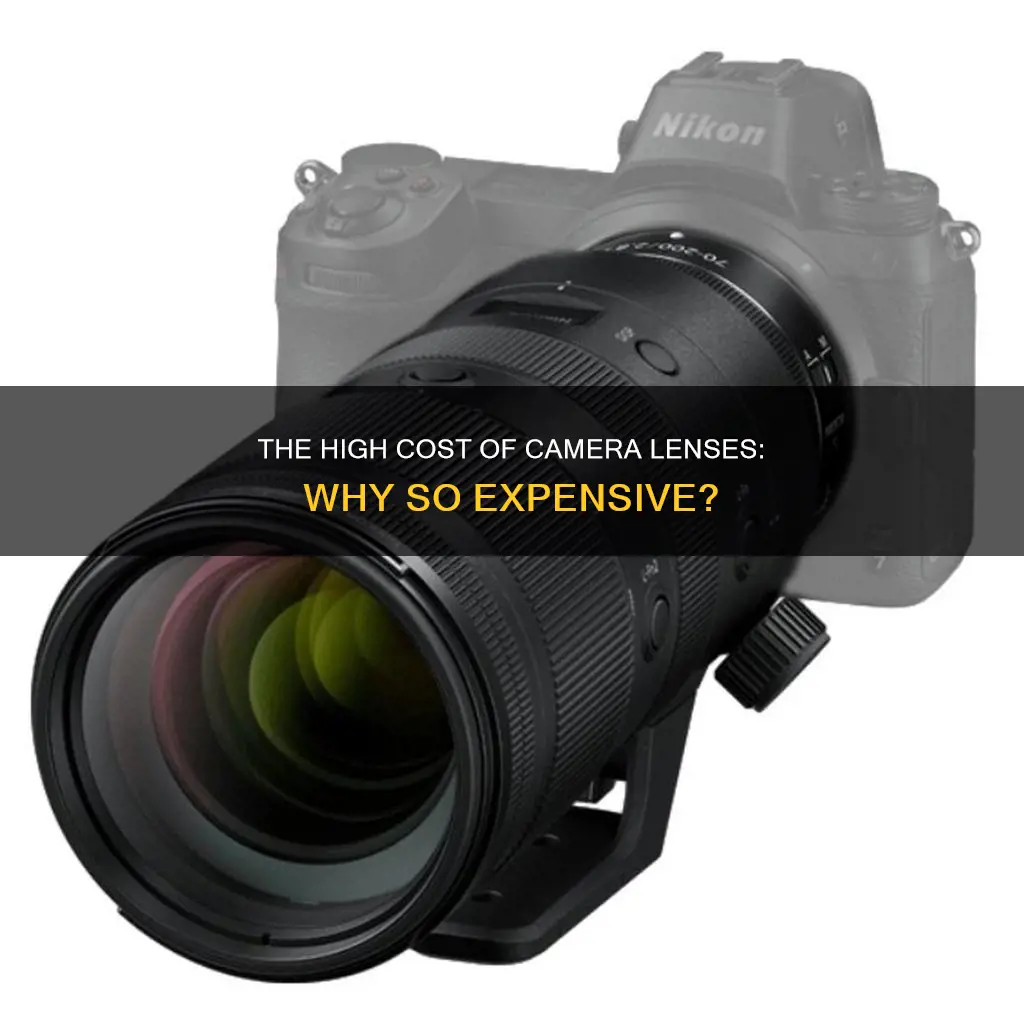
Camera lenses can be expensive due to a variety of factors, including production costs, quality of components, and market trends.
The cost of manufacturing camera lenses, particularly professional-grade lenses, can be high due to the use of advanced materials and intricate production techniques. These lenses often undergo rigorous testing and inspection to ensure the highest quality, which further adds to their expense. Additionally, the assembly process for professional lenses may involve more manual labour, with experienced engineers shaping and handling the glass elements, as opposed to the largely automated production of consumer-grade lenses.
The quality of components also plays a significant role in the pricing of camera lenses. Professional lenses tend to incorporate high-grade optics, complex optical formulas, and advanced coatings to enhance image quality, reduce aberrations, and improve durability. The larger maximum aperture in professional lenses also contributes to their higher price tag, as they perform better in low-light conditions and offer superior subject isolation.
Market dynamics and brand reputation also influence the pricing of camera lenses. The niche market for high-end camera equipment, targeted at professionals or enthusiasts, means that manufacturers need to recoup their investment across a smaller number of units sold. Additionally, certain brands, such as Leica, are associated with handcrafted precision and centralised production, which further justifies their premium pricing.
While camera lenses can be expensive, it's important to note that there are also affordable options available, particularly in the second-hand market, allowing photographers to access quality equipment without breaking the bank.
| Characteristics | Values |
|---|---|
| Materials | Durable metals, advanced composites, weather-resistant coatings, full-frame sensors, image stabilization systems, autofocus systems, high-speed processors |
| Research and Development | Rigorous and extensive testing and quality assurance process, patented and protected by intellectual property rights |
| Production Runs | Smaller production runs, more labor-intensive, higher unit cost |
| Market | Niche market of professional photography, smaller target audience, high-end market |
| Manufacturing Techniques | More advanced manufacturing techniques, hand-assembled, hand-pressed, shaped and handled by experienced engineers |
| Quality Assurance | Higher quality thresholds, rigorous testing and inspection |
| Lens Elements | More spherical, extra-low dispersion, and fluorite lenses, special coatings |
| Consumer Lenses | Variable apertures, slow autofocus motors, plastic and aluminum parts, APS-C format, smaller image circles |
| Professional Lenses | Constant apertures, fast autofocus motors, brass/metal parts, full-frame format, larger image circles |
What You'll Learn

High-quality materials and technology
Camera lenses are expensive because they are made with high-quality materials and technology. The production of such lenses is limited in number, and the process is more labour-intensive, which increases the cost.
High-end camera lenses are made with durable metals, advanced composites, and weather-resistant coatings. These materials are more expensive to buy and require advanced manufacturing techniques. For example, camera bodies made from aerospace-grade aluminium and magnesium alloys are more durable and resistant to wear but also more expensive.
The glass elements in high-end lenses go through rigorous testing and inspection, with only the highest-grade optics making their way into pro-grade lenses. These elements are sometimes hand-pressed, shaped, and handled by experienced engineers, who run both visual and computerized inspections to detect any potential problems.
In addition, high-end lenses have more complex optical formulas, requiring many optical elements to reduce or correct various lens aberrations. They also have special coatings, such as Nikon's Super Integrated Coating (SIC) and Nano Crystal Coat, which reduce internal reflections, improve sharpness, contrast, and colours, and reduce ghosting and flare.
The production of high-end lenses is also more labour-intensive. They are often hand-assembled, with only the best components (mostly brass/metal) used. This increases the production costs compared to consumer-grade lenses, which are mostly assembled by machines using cheaper/lower-end plastic and aluminium parts.
Lens and Camera Compatibility: Are Lenses Camera-Specific?
You may want to see also

Lengthy research and development
The research and development of camera lenses, in particular, can be incredibly time-consuming and intricate. Lens manufacturers may spend a considerable amount of time developing and testing various optical formulas and elements to reduce or correct lens aberrations. This process involves multiple iterations and inspections to ensure the highest quality and performance.
Additionally, the production of high-end camera lenses often involves the use of exotic and expensive materials, such as special types of glass and coatings. These materials are crucial for achieving features like bokeh quality, sharpness, and resistance to issues like ghosting and flare. The manufacturing techniques required to work with these materials can also be more advanced and costly.
Moreover, the assembly process for high-end lenses tends to be more labour-intensive and precise. In some cases, glass elements are hand-pressed, shaped, and handled by experienced engineers, ensuring the highest grade optics. This level of craftsmanship and attention to detail naturally contributes to the overall cost of the lens.
The smaller production runs of high-end camera equipment also play a role in the pricing. With limited production numbers, the company's production cost is spread over fewer units, resulting in a higher unit cost. This dynamic is further influenced by the niche market of professional photography, where the target audience is often willing to pay a premium for the best available technology.
Attaching Enlarger Lenses to Cameras: A Step-by-Step Guide
You may want to see also

Smaller production runs
The smaller production runs of high-end camera equipment can be attributed to a few factors. Firstly, the niche market of professional photography plays a significant role. High-end cameras are comparable in price to other luxury goods, such as watches, cars, and jewellery. However, the purpose and target audience of these items differ even though they are expensive. While camera equipment can be used to generate income, luxury goods are often purchased for personal enjoyment. Consequently, the high-end camera market is a niche with a target audience that is more willing to pay a premium for the best available technology.
Another factor contributing to smaller production runs is the lengthy research and development process. Camera manufacturers invest significantly in R&D and technology development, often patenting their innovations. This results in higher costs that are reflected in the final product's price. Moreover, the testing and quality assurance processes for high-end cameras are rigorous and extensive, further increasing the cost.
In summary, smaller production runs of high-end camera equipment are a result of a niche market with a limited audience and the extensive research, development, and testing processes involved. These factors lead to higher production costs per unit, ultimately contributing to the overall high cost of high-end camera equipment.
Cleaning Camera Lenses: DIY Home Solutions
You may want to see also

Comparable to other luxury goods
Camera lenses can be considered luxury goods, and their prices can be compared to those of watches, cars, and jewellery. The niche market of professional photography equipment is one of the reasons for the high prices of camera lenses. The target audience for these items may differ, even though they are expensive. Camera equipment can be used to generate income, whereas luxury goods are often purchased for personal enjoyment. Therefore, the high-end camera market is a niche market, and its target audience is more willing to pay a premium for the best available technology.
The high cost of camera lenses can be attributed to the use of high-quality materials and technology. Camera bodies made from durable metals, advanced composites, and weather-resistant coatings are more expensive to manufacture and source. Full-frame sensors, image stabilization systems, autofocus systems, and high-speed processors are also costly to develop and implement. The smaller production runs of high-end camera equipment and the labour-intensive production process further increase the cost.
The production of high-end camera lenses is often limited in number, and the company's production cost is spread over fewer units, resulting in a higher unit cost. In addition, the rigorous testing and quality assurance processes that high-end camera equipment undergoes drive up the price.
CPU in Camera Lenses: What Does It Mean?
You may want to see also

Precision manufacturing
Materials and Manufacturing Techniques:
The materials used in high-end lenses are carefully selected and meticulously crafted. These lenses often utilise durable metals, advanced composites, and weather-resistant coatings, which come at a higher cost. The manufacturing techniques employed are more sophisticated, requiring precise control and experienced engineers to ensure optimal results.
Complex Optical Designs:
Professional lenses feature intricate optical formulas with multiple elements to correct various aberrations. The design may include aspherical, extra-low dispersion, and fluorite elements, which are costly to manufacture. Each element must be precisely shaped and positioned to achieve the desired optical performance.
Rigorous Testing and Quality Assurance:
Every aspect of a professional lens undergoes rigorous testing and quality assurance checks. The glass elements are meticulously inspected, both visually and using computerised systems, to identify any potential flaws. The strict quality thresholds ensure that only the highest-grade optics make it into these lenses.
Hand-Assembly and Fine-Tuning:
Many professional lenses are hand-assembled by skilled technicians, ensuring precise alignment and attention to detail. This labour-intensive process contributes to the higher cost compared to mass-produced consumer lenses.
Advanced Coatings:
Special coatings, such as Nikon's Super Integrated Coating (SIC) and Nano Crystal Coat, are often applied to professional lenses. These coatings reduce internal reflections, enhance sharpness, improve colour accuracy, and minimise ghosting and flare. Developing and applying these coatings adds to the overall cost.
Autofocus Motors:
Professional lenses typically incorporate fast and accurate autofocus motors, ensuring subjects are swiftly brought into focus. The development and implementation of these advanced autofocus systems contribute to the overall expense of the lenses.
The precision manufacturing of camera lenses involves a meticulous attention to detail, utilising advanced materials, complex designs, and rigorous quality control. Each step in the process contributes to the overall cost, ensuring that photographers can capture exceptional images with consistent performance and durability.
Camera Kit Lenses: Worth the Money or Worthless?
You may want to see also
Frequently asked questions
Camera lenses are expensive because they are complicated and expensive to make. They are precision instruments, and their optical glass is expensive and complex.
Lenses need a lot of elements to correct various aberrations, and fast lenses need big elements, which are much more expensive to manufacture than small ones. Modern lenses are expected to be optically perfect and perform well with ultra-high-resolution sensors, so they are very complex and highly corrected.
Making lenses with special types of glass and coatings is costly. Quality lenses are made by hand to exacting tolerances and require rigorous testing and inspection. They are assembled by a skilled team of technicians.
Yes, camera lenses are a niche product, so manufacturers need to make more profit on each unit sold to recoup their costs. They are also comparable in price to other luxury goods, such as watches, cars, and jewelry, due to the niche market of professional photography.







